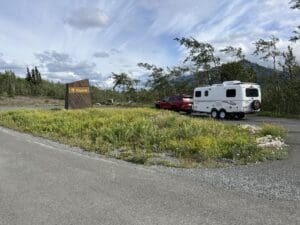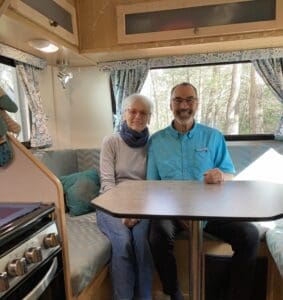How to Winterize Your RV
Winterizing your Escape trailer can seem like quite a daunting task, but we all know how important it is to keeping your trailer safe in freezing conditions. We’ve gone ahead and broken it down, step-by-step, to help anyone complete the task with confidence. Let’s get started!
Winterizing with Antifreeze Only
- Purchase 1-2 gallons of RV approved, non-toxic antifreeze
WARNING: NEVER USE AUTOMOTIVE ANITFREEZE IN YOUR FRESH WATER SYSTEM. AUTOMOTIVE ANITFREEZE IS TOXIC AND NOT FOR USE IN POTABLE (DRINKABLE) WATER SYSTEMS.
-Turn off the electric/propane water heater
-Drain your grey and black wastewater holding tanks
-Find the fresh water tank petcock (located between the axles) and drain all of the water
-Locate and turn water heater hot and cold line bypass valves to bypass position
-Relieve pressure from water heater tank by opening the pressure relief valve in the outside access panel, then drain the water heater by removing the anode (1-1/16” socket wrench). Flush out sediment build-up in water heater, if necessary. Reinstall anode rod with new Teflon tape
-Turn the water pump switch ON, open each faucet and the toilet, both hot and cold modes, until there is no water pouring out. Turn the water pump switch OFF
-Insert open end of winterizing hose, near water pump, into jug of antifreeze. Turn T-valve to select pumping fluid from antifreeze jug, turn the water pump switch ON
-Open the cold-water side of all faucet fixtures individually, leaving each faucet open until the antifreeze, generally pink in color, flows out of the faucets, then close. Repeat for the hot water side, and then run through the shower faucet as well. Don’t forget the exterior shower, if equipped.
-Flush toilet until antifreeze is visible inside the bowl
-Turn the water pump switch OFF
-Empty all water from grey and black tanks and close valves
-Remove antifreeze jug and wipe hose
-Pour at least 1/3 cup of RV antifreeze down each sink and the shower drain to fill P-traps.
-Pour at least one cup of antifreeze down the toilet to winterize the black holding tank.
Winterizing with Compressed Air
- Purchase 1-2 gallons of RV approved, non-toxic antifreeze
WARNING: NEVER USE AUTOMOTIVE ANITFREEZE IN YOUR FRESH WATER SYSTEM. AUTOMOTIVE ANITFREEZE IS TOXIC AND NOT FOR USE IN POTABLE (DRINKABLE) WATER SYSTEMS.
-Turn off the electric/propane water heater
-Drain your grey and black wastewater holding tanks
-Turn the water pump switch OFF
-Find the fresh water tank petcock (located between the axles) and drain all of the water
-Locate and turn water heater hot and cold line bypass valves to bypass position
-Relieve pressure from water heater tank by opening the pressure relief valve in the outside access panel, then drain the water heater by removing the anode (1-1/16” socket wrench). Flush out sediment build-up in water heater, if necessary. Reinstall anode rod with new Teflon tape
-Turn the water pump switch ON for at least 30 seconds to clear any water from the lines
-Connect an air hose with an adapter (blow out plug) to the city water fill connection
-Set the pressure to no greater than 50# (pounds) and blow out the water lines until no water can be seen coming out of the fixtures and lines (including the external shower, if equipped)
-Turn the water pump switch ON, open each faucet and the toilet, both hot and cold modes, until there is no water pouring out. Turn the water pump switch OFF
-Close your grey and black wastewater holding tank valves
-Insert open end of winterizing hose, near water pump, into jug of antifreeze. Turn T-valve to select pumping fluid from antifreeze jug, turn the water pump switch ON
-Open the cold-water side of all faucet fixtures individually, leaving each faucet open until the antifreeze, generally pink in color, flows out of the faucets, then close. Repeat for the hot water side, and then run through the shower faucet as well. Don’t forget the exterior shower, if equipped.
-Flush toilet until antifreeze is visible inside the bowl
-Turn the water pump switch OFF
-Empty all water from grey and black tanks and close valves
-Remove antifreeze jug and wipe hose
-Pour at least 1/3 cup of RV antifreeze down each sink and the shower drain to fill P-traps.
-Pour at least one cup of antifreeze down the toilet to winterize the black holding tank.
What About the Rest of the Trailer?
While the water system has now been winterized, there are a few more items to consider before putting your trailer away for the winter:
-Clean your trailer inside and out, and be sure to focus on the window sills to ensure that water can escape through the weep holes
-If you have an absorption fridge, open the exterior panel and clean out behind the fridge to be sure that dust and dirt don’t collect in there
-Take the opportunity to inspect your tires for wear, side wall cracking, tread depth, and proper inflation. Check your lug nuts for proper torque, and repack wheel bearings if necessary
-Check that each of the pontoon holes (bottom of trailer) are clear of debris and obstruction, and able to drain water as necessary
-Remove your fan filter, blades, and A/C filters. Wipe and wash them to remove dust and dirt. Alternatively, you may be able to use a vacuum hose to clean these without removal.
-Place a pool noodle (or similar) in the middle of the bed to raise the bed and prevent condensation from forming beneath
-Place the cushions in a tent-like formation to allow for proper airflow
-Add baking soda to fridge and freezer compartments, and leave the doors cracked for airflow
-Add a desiccant (such as DampRid) to various compartments that may experience differing temperatures from the main cabin, such as under the bed(s), under the dinette, in the bathroom and within cabinetry
-If concerned about critters, you may choose to add mouse traps and/or bug traps
For the electrical system:
–Unplug your trailer and store the power cable inside your trailer
-Turn off the inverter or switch to ‘OFF’ on the Digital MultiControl Panel (near Victron Display)
-Under the dinette:
-Switch the battery disconnect switch to ‘OFF’
-Disconnect the solar and DC using the breakers
It is important that the lithium (LiFePO4) batteries are never charged in freezing conditions! Bring lithium batteries inside and store at 50% to 80% charge. You may also, optionally, take photos of all connection points on the battery terminals, use tape and mark each appropriate connection, and remove the batteries from the trailer, placing them in an above-freezing location. This is not strictly necessary, though may be used as a precaution.
That’s all there is to it! It may seem like quite the list, but after performing the task once, it will become intuitive and a much easier maintenance item to complete. See you next year!
To receive our newsletter by e-mail, please click the “Subscribe” button in the footer below.











